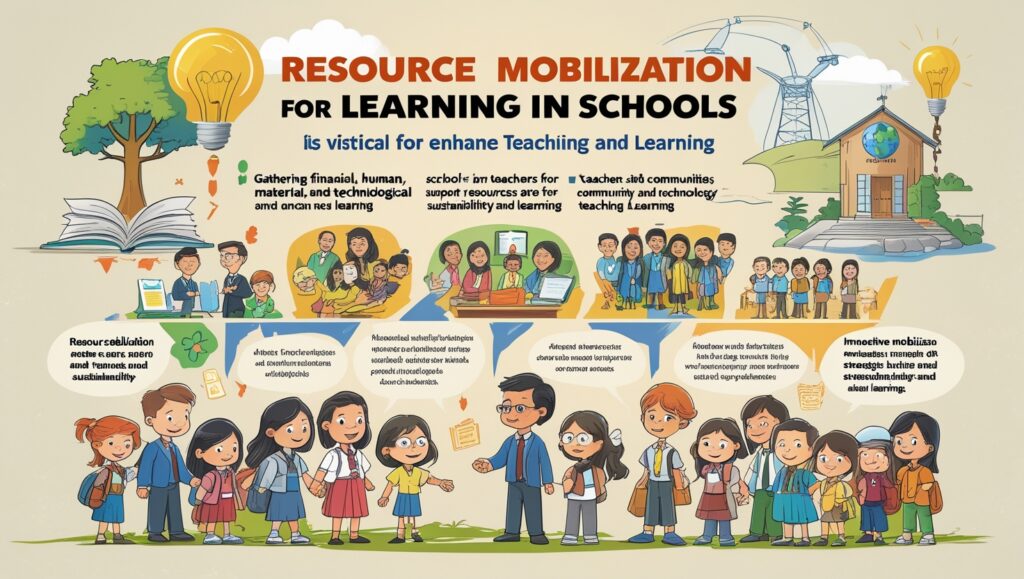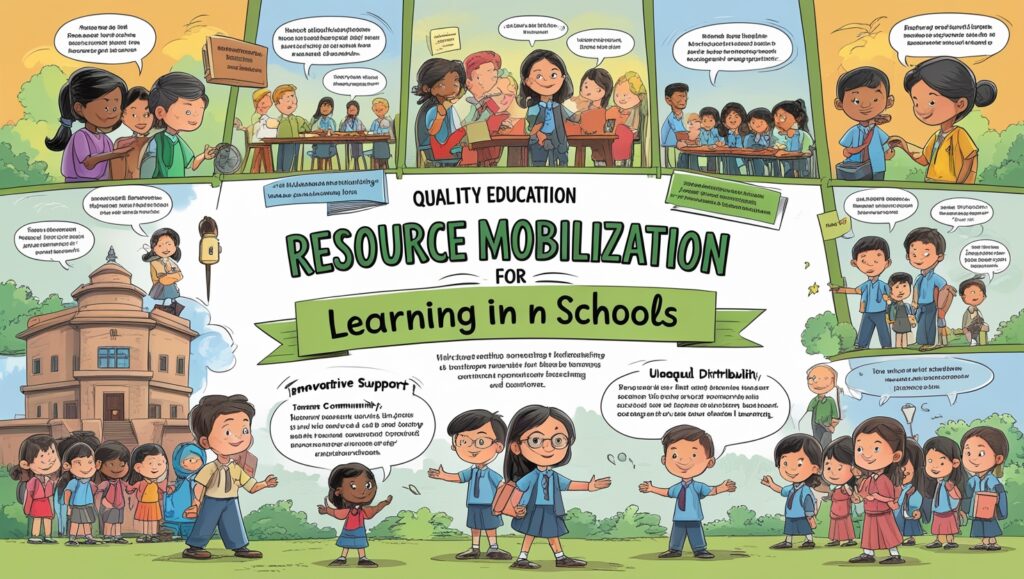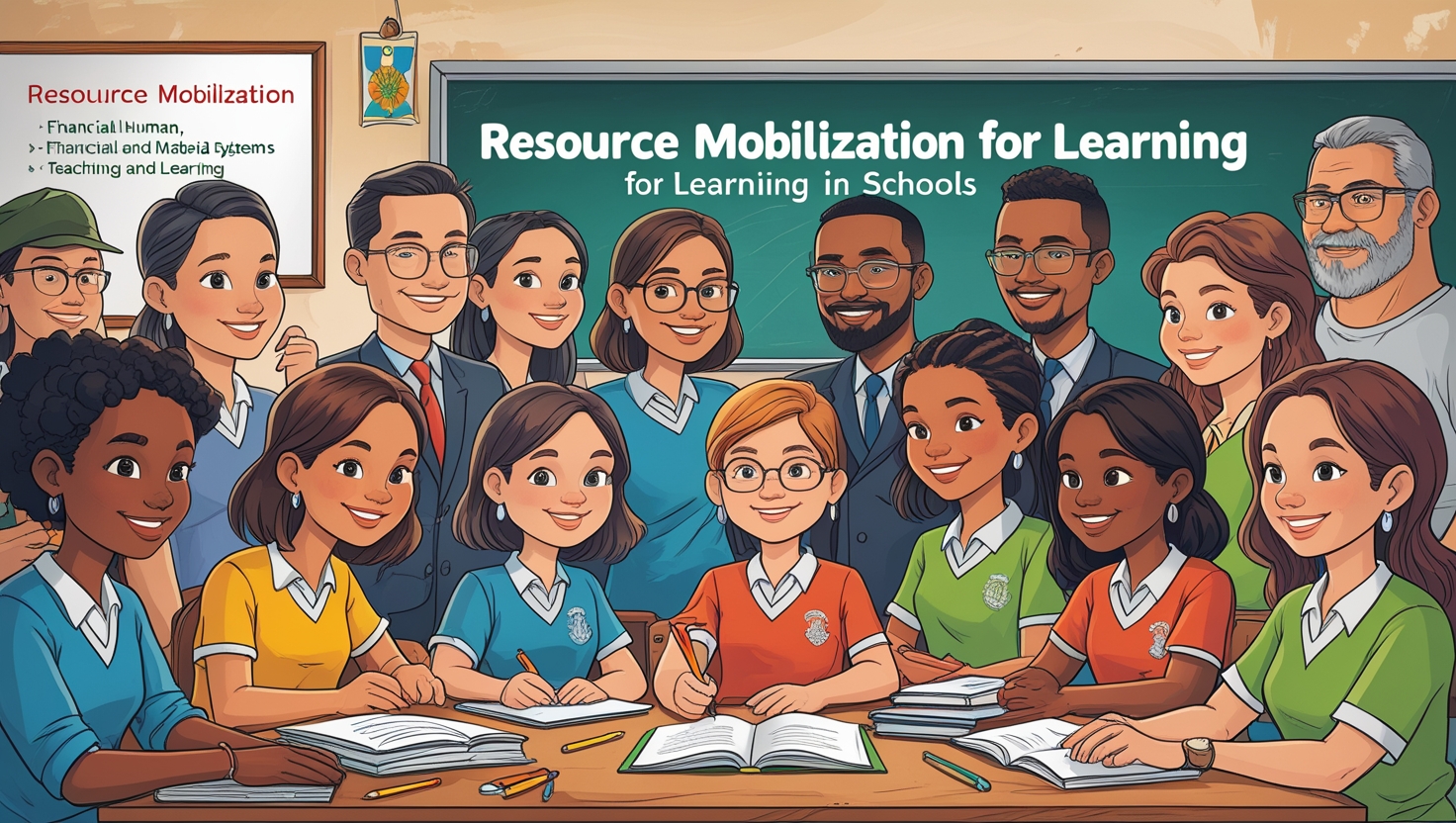Introduction
Resource Mobilization for Learning in Schools, Resource mobilization for learning in schools is an essential component of modern education. It refers to the process of identifying, developing, and utilizing various resources to support the learning environment. These resources include financial inputs, human expertise, technological tools, and community support. Without proper mobilization, schools struggle to provide students with quality learning experiences. Therefore, resource mobilization ensures that every student can access opportunities for growth. Moreover, it builds a sustainable framework for long-term educational improvement. Schools require innovative approaches to gather resources efficiently. Additionally, they must create networks with local communities, non-governmental organizations, and governmental agencies. This collaboration increases the chances of acquiring adequate resources. As a result, teaching becomes more effective, and learning outcomes improve significantly. Furthermore, resource mobilization promotes equity among students by providing equal access to essential learning materials. In short, it is not only about collecting funds but also about organizing people, ideas, and support systems. Hence, resource mobilization remains a vital pillar for achieving educational success in schools.
Importance of Resource Mobilization in Schools
The importance of resource mobilization in schools cannot be overstated. It directly influences the quality of teaching and learning. Firstly, resources ensure that students have access to textbooks, laboratories, libraries, and digital platforms. Without them, the teaching process becomes less effective. Secondly, mobilization allows schools to train teachers and upgrade their skills. This, in turn, improves classroom instruction. Additionally, mobilizing resources promotes innovation in pedagogy and helps schools adopt new teaching strategies. For example, technology-based learning becomes possible only when proper resources are allocated. Moreover, resource mobilization encourages community involvement. Parents, local leaders, and organizations can contribute to the school’s growth. This strengthens the bond between the school and its surroundings. Furthermore, adequate resources help in creating an inclusive environment where students from diverse backgrounds receive equal opportunities. Thus, mobilization promotes fairness in education. Lastly, resource mobilization provides schools with long-term sustainability. With organized planning, schools can continuously improve without depending solely on government funding. Therefore, its importance extends far beyond material gains and includes educational equity and innovation.
Types of Resources Required for Learning
Schools require different types of resources to support effective learning. These resources can be broadly divided into financial, human, material, and technological. Firstly, financial resources are essential for purchasing books, equipment, and infrastructure. Without proper funding, schools cannot function efficiently. Secondly, human resources such as qualified teachers, administrators, and support staff play a vital role. Their expertise directly shapes the learning experience. Moreover, material resources, including classrooms, laboratories, and libraries, are equally important. These provide the physical environment for learning. Additionally, technological resources are now becoming essential. Computers, internet access, and multimedia tools enhance the quality of teaching. Furthermore, intangible resources such as partnerships, community goodwill, and volunteer support strengthen educational activities. Schools also benefit from cultural and social resources, which enrich the curriculum and foster creativity. In short, a balanced combination of all resource types creates a supportive learning environment. Therefore, schools must mobilize resources systematically. With proper mobilization, students receive holistic opportunities to develop academically, socially, and emotionally. Ultimately, these varied resources ensure that learning is inclusive and sustainable.

Role of Teachers in Resource Mobilization
Teachers play a central role in resource mobilization for learning in schools. They act as both educators and mobilizers. Firstly, teachers identify the gaps in learning resources. They know what students need and communicate these requirements to administrators. Secondly, teachers create innovative solutions when resources are limited. For instance, they design low-cost teaching aids to simplify complex topics. Moreover, teachers build networks with parents and communities. Through collaboration, they bring additional support for school activities. Furthermore, teachers contribute by guiding students toward resourceful learning methods. They encourage the use of libraries, digital tools, and peer learning. Additionally, teachers participate in professional development programs to upgrade their own skills. Their improved knowledge becomes an educational resource for students. Teachers also advocate for educational funding from stakeholders. Their influence often convinces local organizations to contribute. In short, teachers act as facilitators of both knowledge and resources. Therefore, their active participation in mobilization enhances school capacity. With dedicated teachers, schools can sustain learning even in resource-constrained environments. Hence, their role remains irreplaceable in educational resource mobilization.
Role of Community in Resource Mobilization
The community plays a powerful role in mobilizing resources for schools. Schools do not exist in isolation; they thrive within communities. Firstly, parents contribute directly by providing materials, volunteering, and offering financial support. This strengthens the school’s resource base. Secondly, local organizations and businesses support schools through donations and sponsorships. They often provide scholarships, equipment, or infrastructure support. Moreover, community members serve as role models and mentors for students. Their real-world experiences enrich classroom learning. Furthermore, community participation builds trust between schools and society. When communities actively engage, students feel more supported. Additionally, cultural and social organizations contribute by sharing knowledge, traditions, and values. This promotes holistic learning. In many cases, community leaders influence government bodies to allocate more resources to schools. Hence, the community serves as a bridge between schools and broader support systems. In short, community involvement is not limited to financial help. It includes moral, cultural, and social contributions. Therefore, mobilizing community resources creates a strong foundation for effective learning and school development.
Role of Government in Resource Mobilization
The government plays a vital role in resource mobilization for schools. It holds the responsibility of ensuring equal educational opportunities for all. Firstly, the government allocates funds to build schools, pay salaries, and provide infrastructure. This forms the backbone of educational systems. Secondly, governments establish policies to encourage private sector involvement in education. Through grants and incentives, schools receive additional support. Moreover, the government provides training programs for teachers to improve their teaching methods. Additionally, governments launch digital initiatives to equip schools with modern technologies. For instance, e-learning platforms and smart classrooms are possible because of government funding. Furthermore, governments regulate the distribution of resources to ensure fairness among rural and urban schools. They also monitor the effective use of allocated funds. Importantly, government support extends to special education programs that promote inclusivity. In short, without government involvement, resource mobilization remains incomplete. Therefore, schools must coordinate with government agencies to maximize benefits. Ultimately, government initiatives provide stability, equity, and sustainability to educational resource mobilization.

Strategies for Effective Resource Mobilization
Schools must adopt effective strategies for mobilizing resources. Firstly, they need clear planning. A well-structured plan outlines the type of resources required and how to acquire them. Secondly, schools should establish partnerships with stakeholders. Collaboration with communities, organizations, and governments increases opportunities. Moreover, fundraising activities such as charity events, alumni contributions, and sponsorships generate additional funds. Additionally, schools can use modern technology for online fundraising campaigns. Furthermore, transparent management of resources builds trust. Stakeholders contribute more when they see proper utilization. Schools must also focus on capacity building. Training teachers and staff ensures that resources are used effectively. Another strategy involves mobilizing volunteer support. Volunteers bring skills, time, and knowledge at no financial cost. Importantly, schools should integrate resource mobilization into their long-term goals. This ensures sustainability rather than short-term benefits. In short, successful mobilization depends on planning, partnerships, and accountability. Therefore, schools should combine traditional methods with innovative approaches. Ultimately, strategic mobilization enhances the quality and accessibility of education for all students.
Challenges in Resource Mobilization
Mobilizing resources for schools is not without challenges. Firstly, financial limitations often restrict schools from fulfilling their needs. Many schools, especially in rural areas, struggle to secure enough funding. Secondly, lack of community participation reduces resource availability. In some cases, parents and communities remain disengaged. Moreover, bureaucratic hurdles delay government resource distribution. Corruption or inefficiency further complicates matters. Additionally, unequal distribution of resources between urban and rural schools creates imbalance. This leads to disparities in learning opportunities. Furthermore, technological resources remain expensive. Many schools cannot afford advanced tools, creating a digital divide. Another challenge is inadequate teacher training. Without skilled teachers, resources are not effectively utilized. Importantly, cultural barriers sometimes limit community involvement in schools. In short, these challenges restrict the effectiveness of resource mobilization. However, with innovative solutions, many of these obstacles can be overcome. Therefore, schools must continuously adapt strategies to address challenges. By doing so, they can ensure equitable access to resources for all learners, regardless of their background or environment.
Solutions to Enhance Resource Mobilization
There are several solutions to enhance resource mobilization in schools. Firstly, schools should strengthen partnerships with local communities. Encouraging parents and businesses to contribute creates additional resource streams. Secondly, transparency in resource management builds trust among stakeholders. This motivates them to support schools more actively. Moreover, adopting technology-based fundraising methods broadens resource networks. Online platforms enable schools to reach donors globally. Furthermore, schools should implement income-generating projects such as small-scale farming or craft sales. These activities provide sustainable financial support. Additionally, teacher training programs must be prioritized. Skilled teachers maximize the use of available resources. Another solution is improving government-school collaboration. Schools must advocate for increased funding and fair resource distribution. Importantly, awareness campaigns should highlight the importance of education. When communities understand the value of education, they contribute more willingly. In short, practical solutions exist to strengthen resource mobilization. Therefore, with creativity, transparency, and cooperation, schools can overcome limitations. Ultimately, these solutions ensure that students receive continuous and high-quality learning support.
Conclusion
In conclusion, resource mobilization for learning in schools is both a necessity and an opportunity. It ensures that students have access to quality education regardless of background. Teachers, communities, and governments all play significant roles in mobilizing resources. Through collective efforts, schools can provide inclusive and sustainable learning environments. Although challenges such as financial limitations and unequal resource distribution persist, solutions exist to address them. With effective strategies, schools can expand opportunities through partnerships, fundraising, and innovative practices. Furthermore, proper utilization of resources ensures long-term benefits. Importantly, resource mobilization is not limited to financial inputs but includes human, technological, and social resources. Thus, it contributes to holistic learning experiences. Therefore, schools must adopt comprehensive strategies for mobilization. In doing so, they prepare students not only for academic success but also for life. Ultimately, resource mobilization strengthens the educational system and promotes equity in society. Hence, it remains a cornerstone for effective and sustainable learning in schools.

Your breakdown of the topic is so well thought out.
Such a thoughtful and well-researched piece. Thank you.
I appreciate the depth and clarity of this post.
pellmy
xs2qk6
Hi there just wanted to give you a bief heads up and let you know a few of the pictures aren’t loading properly.
I’m not sure why but I think its a linking issue.
I’ve tried it in two different internet browsers and both show the same outcome. https://Glassi-app.blogspot.com/2025/08/how-to-download-glassi-casino-app-for.html